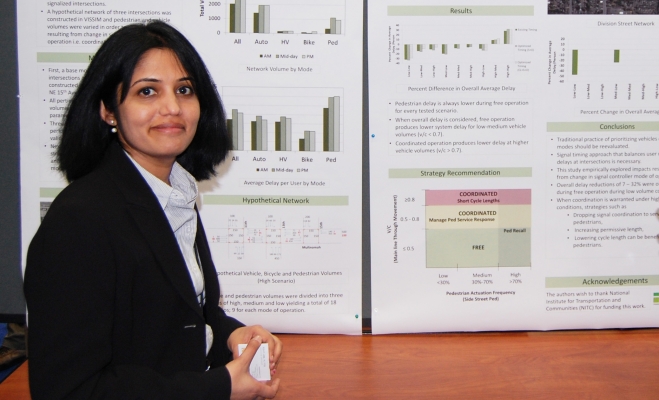Pedestrian signal timing can be improved through control strategies at intersections

- Download the Final Report (PDF)
- Download the Guidbook on Signal Control Strategies for Pedestrians (PDF)
- Download the Project Brief (PDF)
- Watch the recording of the Jan 26, 2017 webinar
Pedestrians often have to wait longer than drivers for the light to change. Increased delay for pedestrians can lead to noncompliance, which can have a negative impact on safety. Most planning efforts geared toward those on foot have tended to focus on safety, but pedestrian efficiency is also important.
Sirisha Kothuri, a research associate in civil engineering at Portland State University, is the principal investigator on the project Improving Walkability Through Control Strategies at Signalized Intersections. Funded by the National Institute for Transportation and Communities, it is an extension of her doctoral dissertation work. Kothuri and co-investigator Edward Smaglik of Northern Arizona University will present their work Sunday, Jan. 8 in a workshop at the TRB conference. Their research looked at pedestrian strategies around the country to determine if they were primarily safety or efficiency measures.
“Generally, pedestrian strategies, if they exist at all, are safety based,” Kothuri said.
So the first task was to identify efficiency-based strategies for pedestrians. Then the research team undertook a simulation approach, simulating an intersection using ASC/3 signal controller software. They looked at different strategies for efficiency and identified what the impacts of each strategy were to all users: pedestrians, cyclists, motor vehicles and heavy vehicles.
“With this project we tried to focus on reducing delay. When and where are efficiency measures most applicable: at certain times of the day, certain types of intersections?” Kothuri said.
Based on the simulation study researchers were able to get a fairly good assessment of the delays experienced by the different users. Using that knowledge, they came up with a scale and a guidebook for practitioners on which measures would be best used when, and what sorts of delays to expect for vehicles and pedestrians.
They also came up with a new algorithm, a pedestrian priority algorithm. They tested it in the simulation environment, then used the learning from that to deploy the algorithm in three different cities: Mesa and Flagstaff, Arizona, and Portland, Oregon. In these cities, they conducted before-and-after studies to learn exactly how much the algorithm reduces pedestrian delay.
"The whole idea is to provide a toolbox for practitioners: One size does not fit all," Kothuri said. Each city has different strategies. Those strategies can also change based on time of day. Practitioners must understand what the operation objective is and then tailor their strategy based on that. The products of this research are intended to provide practitioners with the tools they need to make these decisions.
The project also serves to highlight the idea that transportation professionals should think about pedestrians as an important aspect of traffic.
